|
|

This chapter describes how to configure remote source-route bridging (RSRB). For a complete description of the commands in this chapter, refer to the "Remote Source-Route Bridging Commands" chapter of the Router Products Command Reference Publication
While source-route bridging involves bridging between Token Ring media only, RSRB involves multiple router/bridges separated by non-Token Ring network segments. Figure 25-1 shows an RSRB topology. The virtual ring can extend across any non-Token Ring media supported by RSRB, such as serial, Ethernet, FDDI, and WANs. The type of media you select determines the way you set up RSRB.

Cisco's remote source-route bridging software implementation includes the following features:
To configure RSRB, perform the tasks in one of the following sections:
After you configure RSRB, you can establish SAP prioritization by performing the tasks described in the "Establish SAP Prioritization" section later in this chapter.
To tune and maintain the RSRB network, perform the tasks in the following sections:
See the end of this chapter for "RSRB Configuration Examples."
Configuring RSRB using the direct encapsulation method uses an HDLC-like encapsulation to pass frames over a single physical network connection between two routers attached to Token Rings. Use this method when you run source-route bridge traffic over point-to-point, single-hop, serial, or LAN media. Although this method does not have the flexibility of the TCP approach, it provides the best performance of the three methods because it involves less overhead.To configure a remote source-route bridge to use a point-to-point serial line or a single Ethernet, or a single FDDI hop, perform the tasks in the following sections:
In our implementation of RSRB, whenever you connect Token Rings using non-Token Ring media, you must treat that non-Token Ring media as a virtual ring by assigning it to a ring group. Every router/bridge with which you wish to exchange Token Ring traffic must be a member of this same ring group. These router/bridges are referred to as remote peer bridges. The ring group is therefore made up of interfaces that reside on separate routers.
A ring group must be assigned a ring number that is unique throughout the network. It is possible to assign different interfaces on the same router to different ring groups, if, for example, you plan to administer them as interfaces in separate domains.
To define or remove a ring group, perform one of the following tasks in global configuration mode:
| Task | Command |
|---|---|
Define a ring group. | source-bridge ring-group ring-group1 |
Remove a ring group. | no source-bridge ring-group ring-group |
| 1This command is documented in the "Source-Route Bridging Commands" chapter of the Router Products Command Reference publication. |
The interfaces that you identify as remote peer bridges must be serial, Ethernet, FDDI, or Token Ring interfaces. On a serial interface, you must use HDLC encapsulation. To identify remote-peer bridges, perform the following task in global configuration mode:
| Task | Command |
|---|---|
Define the ring group and identify the interface over which to send SRB traffic to another router/bridge in the ring group. | source-bridge remote-peer ring-group interface interface-name [mac-address] [lf size] |
Configure a source-bridge remote peer command for each peer router that is part of the virtual ring. When using Direct encapsulation, you do not need to configure a local router id.
You can assign a keepalive interval to the remote source-bridging peer. Perform the following task in interface configuration mode:
| Task | Command |
|---|---|
Define the keepalive interval of the remote source-bridging peer. | source-bridge keepalive seconds |
Enable SRB on each interface through which source-route bridging traffic will pass. The value you specify in the target ring parameter should be the ring group number you have assigned to the interface. To enable SRB on an interface, perform the following task in interface configuration mode:
| Task | Command |
|---|---|
Enable source-route bridging on an interface. | source-bridge local-ring bridge-number target-ring1 |
| 1This command is documented in the "Source-Route Bridging Commands" chapter of the Router Products Command Reference publication |
Encapsulating the source-route bridged traffic inside IP datagrams passed over a Fast-Sequenced Transport (FST) connection between two router/bridges is not as fast as direct encapsulation, but it outperforms IP encapsulation over a TCP connection because it has lower overhead. However, this method is fast-switched and does not support any IP level functions including local acknowledgment or fragmentation. Nor is it suitable for use in networks that tend to reorder frame sequences.
To configure a remote source-route bridge to use IP encapsulation over an FST connection, you must perform the tasks in the following sections:
For an example of how to configure RSRB over an FST connection, see the "RSRB Using IP Encapsulation over an FST Connection Example" section later in this chapter.
To set up an FST peer name and identify an IP address to be used by the local router, perform the following task in global configuration mode:
| Task | Command |
|---|---|
Set up an FST peer name and provide the local router with an IP address. | source-bridge fst-peername local-interface-address |
In our implementation of RSRB, whenever you connect Token Rings using non-Token Ring media, you must treat that non-Token Ring media as a virtual ring by assigning it to a ring group. Every router/bridge with which you wish to exchange Token Ring traffic must be a member of this same ring group. Therefore, after you set up an FST peer name, define a ring group. For more information about defining a ring group, see the "Define a Ring Group in SRB Context" section of the "Configuring Source-Route Bridging" chapter.
All of the router/bridges with which you want to exchange Token Ring traffic are referred to as remote peer bridges. The remote peers can be at the other end of an FST connection. To identify the remote peers, perform the following task in global configuration mode:
| Task | Command |
|---|---|
Identify your peers and specify an FST connection. | source-bridge remote-peer ring-group fst ip-address [lf size] |
Specify one source bridge remote peer command for each FST peer router that is part of the virtual ring. Also specify one source bridge remote peer command to identify the IP address of the local router. The IP address you specify should be the IP address the router tries to reach.
You can assign a keepalive interval to the RSRB peer. Perform the following task in interface configuration mode:
| Task | Command |
|---|---|
Define the keepalive interval of the RSRB peer. | source-bridge keepalive seconds |
Enable SRB on each interface through which SRB traffic will pass. Make the value of the target ring parameter you specify the ring group number you assigned to the interface. To enable SRB on an interface, perform the following task in interface configuration mode:
| Task | Command |
|---|---|
Enable local SRB on a Token Ring interface. | source-bridge local-ring bridge-number target-ring |
In cases where FST is fast-switched, in either the routers configured for FST or in the routers contained within the IP "cloud" between a pair of FST peers, only one path will be used at a given time between the two FST peers. This greatly decreases the likelihood that frames will arrive at one peer in a different sequence than frames sent from a remote peer. In the rare cases where this happens, the FST code on the receiving peer discards the out-of-order frame. Thus the Token Ring end hosts rarely lose a frame over the FST router cloud, and performance levels remain adequate.
The same conditions hold true for any slow-switched topology that provides only a single path (for example, a single X.25 network cloud) between the peers. Similarly, if two slow-switched paths are of very different costs such that one always will be chosen over the other, the chances of having frames received out of sequence are also rare.
However, if two or more slow-switched paths of equal cost exist between the two routers (such as two parallel X.25 networks), the routers alternate in sending packets between the two or more equal-cost paths. This results in a high probability of frames arriving out of sequence at the receiver. In such cases, the FST code disposes of every out-of-sequence packet, leading to a large number of drops at the router. This requires that the end hosts retransmit frames, greatly reducing overall throughput.
When such parallel paths exist, it is strongly recommended that one be chosen over the other as the preferred path. This can be done by specifying a higher bandwidth for the path that contains the direct connections to the two or more parallel paths on the router.
Do not use FST when the probability routinely exists for frames to lose their ordering in your network. If you have a network where frames are routinely reordered, it is far better to use the TCP protocol for remote source-route bridging, because it provides the overhead necessary to bring frames back in order on the receiving router. FST, to remain fast, does not provide for such a mechanism, and will toss out-of-order frames.
Encapsulating the source-route bridged traffic inside IP datagrams passed over a TCP connection between two router/bridges offers lower performance than the other two methods, but is the appropriate method to use under the following conditions:
To configure a remote source-route bridge to use IP encapsulation over a TCP connection, you must perform the tasks in the following sections:
In our implementation, whenever you connect Token Rings using non-Token Ring media, you must treat that non-Token Ring media as a virtual ring by assigning it to a ring group. Every router/bridge with which you wish to exchange Token Ring traffic must be a member of this same ring group. For more information about defining a ring group, see the "Define a Ring Group in SRB Context" section of the "Configuring Source-Route Bridging" chapter of this document.
To identify the remote peers, perform the following task in global configuration mode:
Specify one source-bridge remote peer command for each peer router that is part of the virtual ring. Configure an additional source-bridge remote peer command to identify the IP address to be used by the local router.
You can assign a keepalive interval to the remote source-bridging peer. Perform the following task in interface configuration mode:
| Task | Command |
|---|---|
Define the keepalive interval of the remote source-bridging peer. | source-bridge keepalive seconds |
To enable SRB on an interface, perform the following task in interface configuration mode:
| Task | Command |
|---|---|
Enable local source-route bridging on a Token Ring interface. | source-bridge local-ring bridge-number target-ring |
The value of the target ring parameter you specify should be the ring group number.
In our implementation, whenever you connect Token Rings using non-Token Ring media, you must treat that non-Token Ring media as a virtual ring by assigning it to a ring group. Every router/bridge with which you wish to exchange Token Ring traffic must be a member of this same ring group. For more information about defining a ring group, see the "Define a Ring Group in SRB Context" section of the "Configuring Source-Route Bridging" chapter of this document."
To configure RSRB fast switching, you must perform the tasks in the following sections:
Identify the remote peer with which the router will communicate. To identify the remote peers, perform the following task in global configuration mode:
You must identify a remote peer for each interface you configure for remote source-route bridging. The IP address you specify is the IP address the router tries to reach.
To assign a keepalive interval to the remote peer, perform the following task in interface configuration mode:
| Task | Command |
|---|---|
Define the keepalive interval of the remote peer. | source-bridge keepalive seconds |
To enable SRB on an interface, perform the following task in interface configuration mode:
| Task | Command |
|---|---|
Enable local SRB on a Token Ring interface. | source-bridge local-ring bridge-number target-ring |
The value of the target ring parameter you specify should be the ring group number.
Encapsulating the source-route bridged traffic inside IP datagrams passed over a TCP connection between two router/bridges with local acknowledgment enabled is appropriate when you have LANs separated by wide geographic distances and you want to avoid time delays, multiple retransmissions, or loss of user sessions.
Logical Link Control-Type 2 (LLC2) is an ISO standard data link level protocol used in Token Ring networks. LLC2 was designed to ensure reliable transmission of data across LAN media with minimal or predictable time delays. With the advent of RSRB and wide area network (WAN) backbones, LANs are now separated by wide, geographic distances spanning countries and continents. As a result, these LANs have time delays that are longer than LLC2 allows for bidirectional communication between hosts. The local acknowledgment capability in router/bridges supporting remote source-route bridging addresses the problem of unpredictable time delays, multiple retransmissions, and loss of user sessions.
In a typical LLC2 session, when host A sends a frame to host B, the sending host A expects host B to respond positively or negatively in a certain amount of predefined time commonly called the T1 time. If host A does not receive an acknowledgment of the frame it sent to host B within the T1 time, it will retry a number of times (normally 8 to 10). If there is still no response from host B, host A will drop the session.
Figure 25-2 illustrates an LLC2 session. A 37x5 on a LAN segment can communicate with a 3x74 on a different LAN segment separated via a wide-area backbone network. Frames are transported between Router A and Router B using RSRB. However, the LLC2 session between the 37x5 and the 3x74 is still end-to-end; that is, every frame generated by the 37x5 traverses the backbone network to the 3x74, and the 3x74, on receipt of the frame, acknowledges it.
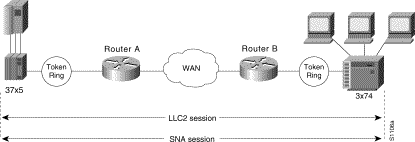
On backbone networks consisting of slow serial links, the T1 timer on end hosts could expire before the frames have a chance to reach the remote hosts, causing the end host to retransmit. This results in duplicate frames reaching the remote host at the same time as the first frame also reached the remote host, albeit slowly. These frame duplications break the LLC2 protocol, resulting in the loss of sessions between the two IBM machines.
One way to solve this time delay problem is to increase the timeout value on the end nodes to account for the maximum transit time between the two end machines. However, in networks consisting of hundreds or even thousands of nodes, every machine would need to be reconfigured with new values. With local acknowledgment for LLC2 turned on, the LLC2 session between the two end nodes would not be end-to-end, but instead, terminates at two local routers. Figure 25-3 shows the LLC2 session with the 37x5 ending at Router A and the LLC2 session with the 3x74 ending at Router B. Both Router A and Router B execute the full LLC2 protocol as part of local acknowledgment for LLC2.

Enabling local acknowledgment for LLC2 has the following advantages:
To configure a remote source-route bridge to use IP encapsulation over a TCP connection, perform the tasks in the following sections:
In our implementation, whenever you connect Token Rings using non-Token Ring media, you must treat that non-Token Ring media as a virtual ring by assigning it to a ring group. Every router/bridge with which you wish to exchange Token Ring traffic must be a member of this same ring group. For more information about defining a ring group, see the "Define a Ring Group in SRB Context" section of the "Configuring Source-Route Bridging" chapter of this document.
To enable LLC2 local acknowledgment, perform the following task in global configuration mode:
| Task | Command |
|---|---|
Enable LLC2 local acknowledgment on a per-remote-peer basis. | source-bridge remote-peer ring-group tcp ip-address local-ack |
You must use one instance of the source-bridge remote-peer command for each interface you configure for RSRB.
To enable SRB on an interface, perform the following task in interface configuration mode:
| Task | Command |
|---|---|
Enable local SRB on a Token Ring interface. | source-bridge local-ring bridge-number target-ring |
The value of the target ring parameter you specify should be the ring group number.
For an example of how to configure RSRB with local acknowledgment, see the "RSRB with Local Acknowledgment Example" section later in this chapter.
To configure some sessions on a few rings to be locally acknowledged while the remaining sessions are passed through, perform the following task in global configuration mode:
| Task | Command |
|---|---|
Configure a router for passthrough. | source-bridge passthrough ring-group |
LLC2 local acknowledgment can only be enabled with TCP remote peers (as opposed to LAN or direct serial interface remote peers) because the routers need the reliable transmission of TCP to provide the same reliability that an LLC2 LAN end-to-end connection provides. Therefore, the direct media encapsulation options for the source-bridge remote-peer command cannot be used.
If the LLC2 session between the local host and the router terminates in either router, the other will be informed to terminate its connection to its local host.
If the TCP queue length of the connection between the two routers reaches 90 percent of its limit, the routers send Receiver-not-Ready (RNR) messages to the local hosts until the queue limit is reduced to below this limit.
The configuration of the LLC2 parameters for the local Token Ring interfaces can affect overall performance. Refer to the "Configuring LLC2 and SDLC Parameters" chapter in this manual for more details about fine-tuning your network through the LLC2 parameters.
The routers at each end of the LLC2 session execute the full LLC2 protocol, which can result in some overhead. The decision to turn on local acknowledgment for LLC2 should be based on the speed of the backbone network in relation to the Token Ring speed. For LAN segments separated by slow-speed serial links (for example, 56 kbps), the T1 timer problem could occur more frequently. In such cases, it may be wise to turn on local acknowledgment for LLC2. For LAN segments separated by a FDDI backbone, backbone delays will be minimal; in such cases, local acknowledgment for LLC2 should not be turned on. Speed mismatch between the LAN segments and the backbone network is one criterion to be used in the decision to use local acknowledgment for LLC2.
There are some situations (such as host B failing between the time host A sends data and the time host B receives it) in which host A would behave as if, at the LLC2 layer, data was received when it actually was not, because the router acknowledges that it received data from host A before it confirms that host B can actually receive the data. But because both NetBIOS and SNA have error recovery in situations where an end device goes down, these higher-level protocols will resend any missing or lost data. These transaction request/confirmation protocols exist above LLC2, so they are not affected by tight timers, as is LLC2. They also are transparent to local acknowledgment.
If you are using NetBIOS applications, note that there are two NetBIOS timers---one at the link level and one at the next higher level. Local acknowledgment for LLC2 is designed to solve session timeouts at the link level only. If you are experiencing NetBIOS session timeouts, you have two options:
You can configure direct Frame Relay encapsulation to allow the RSRB peers to send RSRB protocol packets on a Frame Relay PVC. This eliminates the overhead introduced by Transmission Control Protocol/Internet Protocol (TCP/IP)-encapsulated Frame Relay packets.
Figure 25-4 illustrates direct Frame Relay encapsulation between RSRB peers.

The RSRB direct encapsulation design can use RFC 1490 format or Cisco Frame Relay encapsulation for routed packets.
To configure RSRB direct Frame Relay encapsulation, perform the following tasks, starting in interface configuration mode:
| Task | Command |
|---|---|
Specify the serial interface on which Frame Relay is configured. | source-bridge remote-peer bridge-group interface serial [port dlci dlci] |
Specify the DLCI number onto which the RSRB traffic is to be mapped. |
| 1This command is documented in the "SNA Frame Relay Access Support Commands" chapter of the Router Products Command Reference publication. |
The SAP prioritization feature allows you to use SAP priority lists and filters to specify the priority of one protocol over another across an RSRB or SDLLC WAN.
To establish a SAP priority list, perform the following tasks:
| Task | Command |
|---|---|
Define the priority list. | sap-priority-list number queue-keyword [dsap ds] [ssap ss] [dmac dm] [smac sm] |
Define the priority on an interface. | sap-priority number |
Apply the priority list to an interface. | priority-group list |
You can define SAP filters and NetBIOS filters on Token Ring and Ethernet interfaces.
To filter by LSAP address on the RSRB WAN interface, perform the following global configuration tasks as appropriate:
| Task | Command |
|---|---|
Filter by LSAP address (TCP encapsulation). | rsrb remote-peer ring-group tcp ip-address lsap-output-list access-list-number |
Filter by LSAP address (FST encapsulation). | rsrb remote-peer ring-group fst ip-address lsap-output-list access-list-number |
Filter by LSAP address (direct encapsulation). | rsrb remote-peer ring-group interface interface-name lsap-output-list access-list-number |
To filter packets by NetBIOS station name on an RSRB WAN interface, perform one of the following global configuration tasks as appropriate:
| Task | Command |
|---|---|
Filter by NetBIOS station name (TCP encapsulation). | rsrb remote-peer ring-group tcp ip-address netbios-output-list name |
Filter by NetBIOS station name (FST encapsulation). | rsrb remote-peer ring-group fst ip-address netbios-output-list name |
Filter by NetBIOS station name (direct encapsulation). | rsrb remote-peer ring-group interface interface-name netbios-output-list host |
The following sections describe how to configure features that enhance network performance by reducing the number of packets that traverse the backbone network:
You can prioritize SNA traffic on an interface configured for either serial tunnel (STUN) or RSRB communication. The SNA local LU address prioritization feature allows SNA traffic to be prioritized according to the address of the logical units (LU) on the FID2 transmission headers. Currently, only dependent LUs are supported. The prioritization takes place on LU-LU traffic between an SNA Node type 5 or Node type 4, and Node type 2.
Figure 25-5 shows how SNA local address prioritization can be used.
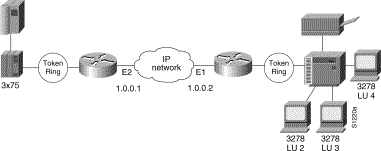
In Figure 25-5, the IBM mainframe is channel-attached to a 3x75 FEP, which is connected to a cluster controller via RSRB. Multiple 3270 terminals and printers, each with a unique local LU address, are then attached to the cluster controller. By applying SNA local LU address prioritization, each LU associated with a terminal or printer can be assigned a priority; that is, certain users can have terminals that have better response time than others, and printers can have lowest priority.
With the SNA local LU address prioritization feature, you can establish queuing priorities based on the address of the logical unit. To prioritize traffic, perform both of the following tasks in global configuration mode:
| Task | Command |
|---|---|
Step 1 Map LUs to TCP port numbers. | locaddr-priority-list list-number address-number queue-keyword [dsap ds] [dmac dm] |
Step 2 Set the priority of TCP port numbers. | priority-list list-number protocol protocol-name priority tcp port-number |
To prioritize SNA traffic across the SNA backbone network, you can enable the class of service feature. This feature is useful only between FEP-to-FEP (PU4-to-PU4) communication across the non-SNA backbone. It allows important FEP traffic to flow on high-priority queues.
To enable class of service, IP encapsulation over a TCP connection and LLC2 local acknowledgment must be enabled.
To enable class of service, perform the following task in global configuration mode:
| Task | Command |
|---|---|
Enable class-of-service. |
To assign a priority group to an input interface, perform the following task in interface configuration mode:
| Task | Command |
|---|---|
Assign a priority group to an input interface. | locaddr-priority list-number |
You can configure the largest frame size that is used to communicate with any peers in the ring group.
Generally, the router and the LLC2 device with which it communicates should support the same maximum SDLC I-frame size. The larger this value, the more efficiently the line is used, thus increasing performance.
Faster screen updates to 3278-style terminals often result by configuring the Token Ring FEP to send as large an I-frame as possible and then allowing the router to segment the frame into multiple SDLC I-frames.
After you configure the Token Ring FEP to send the largest possible I-frame, configure the router to support the same maximum I-frame size. The default is 516 bytes. The maximum value the router can support is 8144 bytes.
To configure the largest frame size, perform the following task in global configuration mode:
| Task | Command |
|---|---|
Specify the largest frame size used to communicate with any peers in the ring group. | source-bridge largest-frame ring-group size |
To display a variety of information about the RSRB network, perform one or more of the following tasks in EXEC mode:
| Task | Command |
|---|---|
Display internal state information about the Token Ring interfaces in the system. | |
Provide high-level statistics about the state of source bridging for a particular interface. | |
Show the current state of any current local acknowledgment for both LLC2 and SDLLC connections. | show local-ack |
In addition to the EXEC-mode tasks to maintain the RSRB network, you can perform the following task in global configuration mode:
| Task | Command |
|---|---|
Limit the size of the backup queue for RSRB to control the number of packets that can wait for transmission to a remote ring before they start being thrown away. | source-bridge tcp-queue-max number |
The following sections provide RSRB configuration examples:
The following is the configuration file for direct Frame Relay encapsulation between RSRB peers:
source-bridge ring-group 200 source-bridge remote-peer 200 frame-relay interface serial0 30 ! interface serial 0 mtu 3000 no ip address encapsulation frame-relay clockrate 56000 frame-relay lmi-type ansi frame-relay map rsrb 30 ! ! interface TokenRing 0 ip address 10.10.10.1 255.255.255.0 ring-speed 16 multiring all source-bridge active 102 1 200 source-bridge spanning
Figure 25-6 illustrates a configuration of two router/bridges configured for RSRB using TCP as a transport. Each router has two Token Rings. They are connected by an Ethernet segment over which the source-route bridged traffic will pass. The first router configuration is a source-route bridge at address 131.108.2.29.
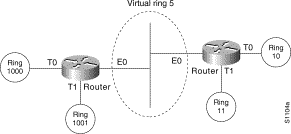
Using TCP as the transport, the configuration for the source-route bridge at address 131.108.2.29 as depicted in Figure 25-6 is as follows:
source-bridge ring-group 5 source-bridge remote-peer 5 tcp 131.108.2.29 source-bridge remote-peer 5 tcp 131.108.1.27 ! interface ethernet 0 ip address 131.108.4.4 255.255.255.0 ! interface tokenring 0 ip address 131.108.2.29 255.255.255.0 source-bridge 1000 1 5 source-bridge spanning ! interface tokenring 1 ip address 131.108.128.1 255.255.255.0 source-bridge 1001 1 5 source-bridge spanning
The configuration of the source-route bridge at 131.108.1.27 is as follows:
source-bridge ring-group 5 source-bridge remote-peer 5 tcp 131.108.2.29 source-bridge remote-peer 5 tcp 131.108.1.27 ! interface ethernet 0 ip address 131.108.4.5 255.255.255.0 ! interface tokenring 0 ip address 131.108.1.27 255.255.255.0 source-bridge 10 1 5 source-bridge spanning ! interface tokenring 1 ip address 131.108.131.1 255.255.255.0 source-bridge 11 1 5 source-bridge spanning
The following configuration enables RSRB/TCP fast switching:
source-bridge ring group 100 source-bridge remote-peer 100 ftcp 198.92.88.138 source-bridge remote-peer 100 ftcp 198.92.88.145
Figure 25-7 shows two routers connecting IBM hosts on Token Rings through an Ethernet backbone.
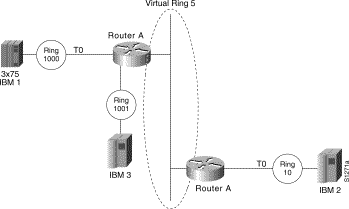
This example configuration enables IP encapsulation over an FST connection. In this configuration, the source-bridge fst-peername global configuration command is used to provide an IP address for the local router, the source-bridge ring-group global configuration command is used to define a ring group, and the source-bridge remote peer command with the fst option is used to associate the remote peer's IP address with the router's ring group and specify the remote peer's remote source-route bridging protocol version number. Because all FST peers support version 2 RSRB, the version keyword is always specified.
The configuration of the source-route bridge at 131.108.2.29 is as follows:
source-bridge fst-peername 131.108.2.29
source-bridge ring-group 5
source-bridge remote-peer 5 fst 131.108.1.27
!
interface ethernet 0
ip address 131.108.4.4 255.255.255.0
!
interface tokenring 0
ip address 131.108.2.29 255.255.255.0
source-bridge 1000 1 5
source-bridge spanning
!
interface tokenring 1
ip address 131.108.128.1 255.255.255.0
source-bridge 1001 1 5
source-bridge spanning
The configuration of the source-route bridge at 131.108.1.27 is as follows:
source-bridge fst-peername 131.108.1.27 source-bridge ring-group 5 source-bridge remote-peer 5 fst 131.108.2.29 ! interface ethernet 0 ip address 131.108.4.5 255.255.255.0 ! interface tokenring 0 ip address 131.108.1.27 255.255.255.0 source-bridge 10 1 5 source-bridge spanning ! interface tokenring 1 ip address 131.108.131.1 255.255.255.0 source-bridge 11 1 5 source-bridge spanning
Figure 25-8 shows a router/bridge configured for RSRB using all types of transport methods.
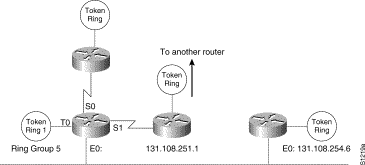
The configuration for the network in Figure 25-8 is as follows:
source-bridge fst-peername 131.108.251.1 source-bridge ring-group 5 source-bridge remote-peer 5 interface serial0 source-bridge remote-peer 5 interface serial1 source-bridge remote-peer 5 interface Ethernet0 0000.0c00.1234 source-bridge remote-peer 5 tcp 131.108.251.1 source-bridge remote-peer 5 fst 131.108.252.4 source-bridge remote-peer 5 tcp 131.108.253.5 ! interface tokenring 0 source-bridge 1 1 5 source-bridge spanning ! interface ethernet 0 ip address 131.108.251.1 255.255.255.0
The two peers using the serial transport method only function correctly if router/bridges at the other end of the serial line have been configured to use the serial transport. The peers must also belong to the same ring group.
In Figure 25-9, a triangular configuration provides the maximum reliability with minimal cost, and one of the links is doubled to gain better bandwidth. In addition to IP and SRB traffic, AppleTalk is also being routed between all the sites. Note that in this configuration, all the sessions between Router C and Router D are locally acknowledged. All the sessions between Router C and Router E are not locally acknowledged and are configured for normal remote source-route bridging. This example shows that not every peer must be locally acknowledged but that local acknowledgment can be turned on or off at the customer's discretion.
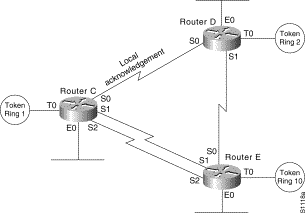
The files that enable this configuration follow.
appletalk routing ! source-bridge ring-group 5 source-bridge remote-peer 5 tcp 132.21.1.1 source-bridge remote-peer 5 tcp 132.21.2.6 local-ack source-bridge remote-peer 5 tcp 132.21.10.200 ! interface TokenRing 0 ip address 132.21.1.1 255.255.255.0 source-bridge 1 1 5 source-bridge spanning multiring all ! interface Ethernet 0 ip address 132.21.4.25 255.255.255.0 appletalk address 4.25 appletalk zone Twilight ! interface Serial 0 ip address 132.21.16.1 255.255.255.0 appletalk address 16.1 appletalk zone Twilight ! interface Serial 1 ip address 132.21.17.1 255.255.255.0 appletalk address 17.1 appletalk zone Twilight ! interface Serial 2 ip address 132.21.18.1 255.255.255.0 appletalk address 18.1 appletalk zone Twilight ! router igrp 109 network 132.21.0.0 ! hostname RouterC
appletalk routing ! source-bridge ring-group 5 source-bridge remote-peer 5 tcp 132.21.1.1 local-ack source-bridge remote-peer 5 tcp 132.21.2.6 source-bridge remote-peer 5 tcp 132.21.10.200 ! interface TokenRing 0 ip address 132.21.2.6 255.255.255.0 source-bridge 2 1 5 source-bridge spanning multiring all ! interface Ethernet 0 ip address 132.21.5.1 255.255.255.0 appletalk address 5.1 appletalk zone Twilight ! interface Serial 0 ip address 132.21.16.2 255.255.255.0 appletalk address 16.2 appletalk zone Twilight ! interface Serial 1 ip address 132.21.19.1 255.255.255.0 appletalk address 19.1 appletalk zone Twilight ! router igrp 109 network 132.21.0.0 ! hostname RouterD
appletalk routing ! source-bridge ring-group 5 source-bridge remote-peer 5 tcp 132.21.1.1 source-bridge remote-peer 5 tcp 132.21.2.6 source-bridge remote-peer 5 tcp 132.21.10.200 ! interface TokenRing 0 ip address 132.21.10.200 255.255.255.0 source-bridge 10 1 5 source-bridge spanning multiring all ! interface Ethernet 0 ip address 132.21.7.1 255.255.255.0 appletalk address 7.1 appletalk zone Twilight ! interface Serial 0 ip address 132.21.19.2 255.255.255.0 appletalk address 19.2 appletalk zone Twilight ! interface Serial 1 ip address 132.21.17.2 255.255.255.0 appletalk address 17.2 appletalk zone Twilight ! interface Serial 2 ip address 132.21.18.2 255.255.255.0 appletalk address 18.2 appletalk zone Twilight ! router igrp 109 network 132.21.0.0 ! hostname RouterE
Figure 25-10 shows two routers configured for remote source-route bridging with local acknowledgment and passthrough over the three serial lines that connect these routers. In turn, five Token Rings connect to each of these routers.
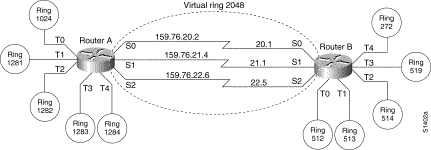
The configuration files for each of these routers follows.
source-bridge ring-group 2048 source-bridge remote-peer 2048 tcp 159.76.1.250 local-ack version 2 source-bridge remote-peer 2048 tcp 159.76.7.250 version 2 source-bridge passthrough 1281 source-bridge passthrough 1282 source-bridge passthrough 1283 source-bridge passthrough 1284 ! interface tokenring 0 ip address 159.76.7.250 255.255.255.0 llc2 ack-max 1 llc2 t1-time 1800 llc2 idle-time 29000 llc2 ack-delay-time 5 source-bridge 1024 1 2048 source-bridge spanning early-token-release multiring all ! interface tokenring 1 ip address 159.76.8.250 255.255.255.0 clns-speed 4 clns mtu 464 source-bridge 1281 1 2048 source-bridge spanning multiring all interface tokenring 2 ip address 159.76.9.250 255.255.255.0 ring-speed 4 clns mtu 4464 source-bridge 1282 1 2048 source-bridge spanning multiring all interface tokenring 3 ip address 159.76.10.250 255.255.255.0 ring speed 4 clns mtu 4464 source-bridge 1283 1 2048 source-bridge spanning multiring all ! interface tokenring 4 ip address 159.78.11.250 255.255.255.0 ring speed 4 clns mtu 4464 source-bridge 1284 1 2048 source-bridge spanning multiring all ! interface serial 0 ip address 159.76.20.2 255.255.255.0 ! interface serial 1 ip address 159.76.21.4 255.255.255.0 ! interface serial 2 ip address 159.76.22.6 255.255.255.0 shutdown ! interface serial 3 no ip address shutdown
source-bridge ring-group 2048 source-bridge remote-peer 2048 tcp 159.76.1.250 version 2 source-bridge remote-peer 2048 tcp 159.76.7.250 local-ack version 2 ! interface tokenring 0 ip address 159.76.1.250 255.255.255.0 llc2 ack-max 2 llc2 t1-time 1900 llc2 idle-time 29000 llc2 ack-delay-time 5 source-bridge 512 1 2048 source-bridge spanning early-token-release multiring all ! interface tokenring 1 ip address 159.76.2.250 255.255.255.0 ring-speed 16 clns mtu 8136 ! source-bridge 513 1 2048 source-bridge spanning early-token-release multiring all ! interface tokenring 2 ip address 159.76.3.250 255.255.255.0 ring speed 16 clns mtu 8136 source-bridge 514 1 2048 source-bridge spanning early-token-release multiring all ! interface tokenring 3 ip address 159.76.4.250 255.255.255.0 ring-speed 4 clns mtu 4464 source-bridge 519 2 2043 source-bridge spanning multiring all ! interface tokenring 4 ip address 159.76.5.250 255.255.255.0 ring-speed 4 clns mtu 4464 source-bridge 272 2 2048 source-bridge spanning multiring all ! interface tokenring ! interface serial 0 ip address 159.76.20.1 255.255.255.0 ! interface serial 1 ip address 159.76.21.3 255.255.255.0 ! interface serial 2 ip address 159.76.22.5 255.255.255.0 ! interface serial 3 no ip address shutdown
Figure 25-11 shows an IBM FEP located in San Francisco communicating with 3174 hosts in Sydney, Paris, and Los Angeles. The session between the FEP and the 3174 system in Los Angeles is not locally terminated, because the distance is great enough to cause timeouts on the line. However, the sessions to Paris and Sydney are locally terminated.
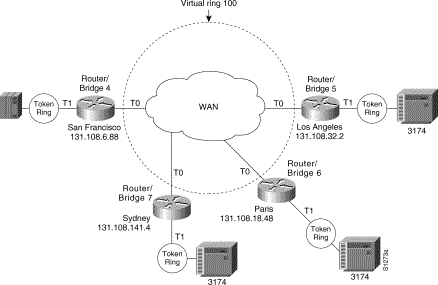
The configuration described in this example is represented in the following sample configuration files.
source-bridge ring-group 100 ! use direct encapsulation across serial link to Los Angeles source-bridge remote-peer 100 direct 131.108.32.2 ! use fast sequenced transport with local termination to Paris source-bridge remote-peer 100 tcp 131.108.18.48 local-ack ! use tcp encapsulation with local termination to Sydney source-bridge remote-peer 100 tcp 131.108.141.4 local-ack ! interface tokenring 0 ! source ring 1, bridge 4, destination ring 100 source-bridge 1 4 100 ! receive up to seven frames before sending an acknowledgment llc2 ack-max 7 ! allow a 30 msec delay before I-frames must be acknowledged llc2 ack-delay-time 30 ! interface tokenring 1 ! source ring 100, bridge 4, destination ring 1 source-bridge 100 4 1
source-bridge ring-group 100 ! use tcp encapsulation with local termination from Sydney source-bridge remote-peer 100 tcp 131.108.6.88 local-ack interface tokenring 0 ! source ring 1, bridge 7, destination ring 100 source-bridge 1 7 100 ! receive up to seven frames before sending an acknowledgment llc2 ack-max 7 ! allow a 30 msec delay before I-frames must be acknowledged llc2 ack-delay-time 30 ! interface tokenring 1 ! source ring 100, bridge 7, destination ring 1 source-bridge 100 7 1
source-bridge ring-group 100 ! use fast sequenced transport with local termination from Paris source-bridge remote-peer 100 tcp 131.108.6.88 local-ack interface tokenring 0 ! source ring 1, bridge 6, destination ring 100 source-bridge 1 6 100 ! receive up to seven frames before sending an acknowledgment llc2 ack-max 7 ! allow a 30 msec delay before I-frames must be acknowledged llc2 ack-delay-time 30 ! interface tokenring 1 ! source ring 100, bridge 6, destination ring 1 source-bridge 100 6 1
source-bridge ring-group 100 ! use direct encapsulation across serial link from Los Angeles source-bridge remote-peer 100 direct 131.108.6.88 interface tokenring 0 ! source ring 1, bridge 5, destination ring 100 source-bridge 1 5 100 ! receive up to seven frames before sending an acknowledgment llc2 ack-max 7 ! allow a 30 msec delay before I-frames must be acknowledged llc2 ack-delay-time 30 ! interface tokenring 1 ! source ring 100, bridge 5, destination ring 1 source-bridge 100 5 1
As Figure 25-12 shows, two routers are connected by two serial lines. Each is configured as a basic remote dual-port bridge, but extended to include both reliability and IP load sharing. When both serial lines are up, traffic is split between them, effectively combining the bandwidth of the connections. If either serial line goes down, all traffic is routed to the remaining line with no disruption. This happens transparently with respect to the end connections, unlike other source-route bridges that would abort those connections.

The sample configuration files that enable this configuration follow.
source-bridge ring-group 5 source-bridge remote-peer 5 tcp 204.31.7.1 source-bridge remote-peer 5 tcp 204.31.8.1 ! interface TokenRing 0 ip address 204.31.7.1 255.255.255.0 source-bridge 1 1 5 source-bridge spanning multiring all ! interface Serial 0 ip address 204.31.9.1 255.255.255.0 ! interface Serial 1 ip address 204.31.10.1 255.255.255.0 ! router igrp 109 network 204.31.7.0 network 204.31.9.0 network 204.31.10.0 ! hostname RouterA
source-bridge ring-group 5 source-bridge remote-peer 5 tcp 204.31.7.1 source-bridge remote-peer 5 tcp 204.31.8.1 ! interface TokenRing 0 ip address 204.31.8.1 255.255.255.0 source-bridge 2 1 5 source-bridge spanning multiring all ! interface Serial 0 ip address 204.31.9.2 255.255.255.0 ! interface Serial 1 ip address 204.31.10.2 255.255.255.0 ! router igrp 109 network 204.31.8.0 network 204.31.9.0 network 204.31.10.0 ! hostname RouterB
Figure 25-13 shows a network that uses RSRB to bridge Token Ring traffic.

The configuration for the network shown in Figure 25-13 follows.
source-bridge ring-group 2624 source-bridge remote-peer 2624 tcp 1.0.0.1 source-bridge remote-peer 2624 tcp 1.0.0.2 local-ack priority ! interface TokenRing 0 source-bridge 2576 8 2624 source-bridge spanning multiring all locaddr-priority 1 ! interface Ethernet 0 ip address 1.0.0.1 255.255.255.0 priority-group 1 ! locaddr-priority-list 1 02 high locaddr-priority-list 1 03 high locaddr-priority-list 1 04 medium locaddr-priority-list 1 05 low ! priority-list protocol ip high tcp 1996 priority-list protocol ip medium tcp 1987 priority-list protocol ip normal tcp 1988 priority-list protocol ip low tcp 1989
source-bridge ring-group 2624 source-bridge remote-peer 2624 tcp 1.0.0.2 source-bridge remote-peer 2624 tcp 1.0.0.1 local-ack priority ! interface TokenRing 0 source-bridge 2626 8 2624 source-bridge spanning multiring all locaddr-priority 1 ! interface Ethernet 0 ip address 1.0.0.2 255.255.255.0 priority-group 1 ! locaddr-priority-list 1 02 high locaddr-priority-list 1 03 high locaddr-priority-list 1 04 medium locaddr-priority-list 1 05 low ! priority-list protocol ip high tcp 1996 priority-list protocol ip medium tcp 1987 priority-list protocol ip normal tcp 1988 priority-list protocol ip low tcp 1989
The following example enables SNA traffic prioritization by LU address:
locaddr-priority-list 1 01 medium locaddr-priority-list 1 02 normal locaddr-priority-list 1 03 low locaddr-priority-list 1 04 high ! priority-list 2 protocol ip low tcp 1996 priority-list 2 protocol ip high tcp 1987 priority-list 2 protocol ip medium tcp 1988 priority-list 2 protocol ip normal tcp 1989 ! interface tokenring 0 source-bridge 123 locaddr-priority 1 interface serial 0 priority-group 2
![]()
![]()
![]()
![]()
![]()
![]()
![]()
![]()
Posted: Wed Mar 17 15:07:09 PST 1999
Copyright 1989-1999©Cisco Systems Inc.